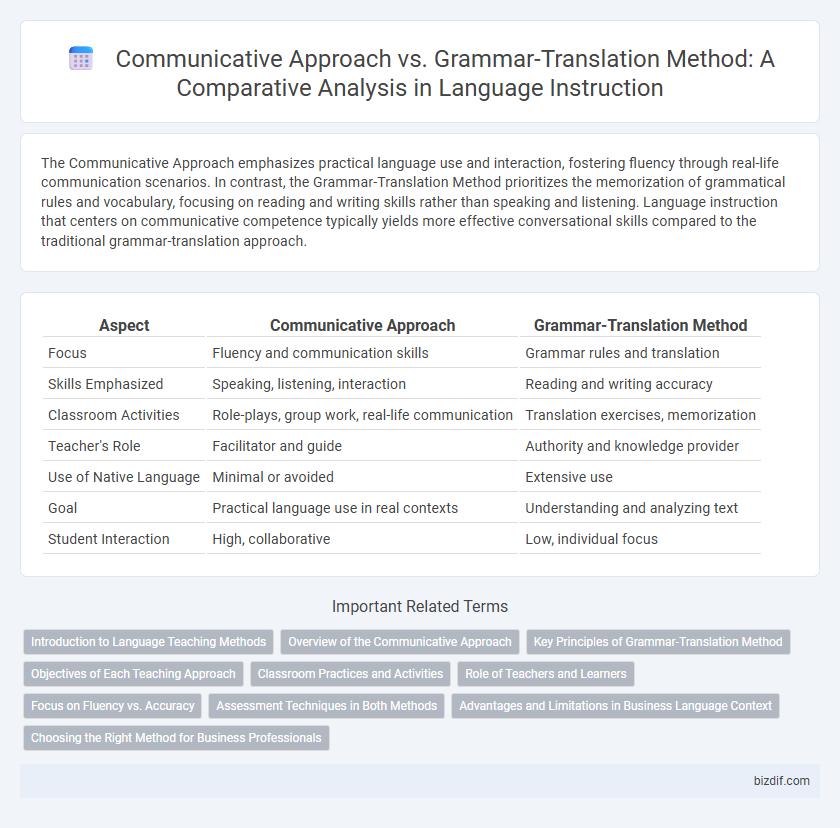The Communicative Approach emphasizes practical language use and interaction, fostering fluency through real-life communication scenarios. In contrast, the Grammar-Translation Method prioritizes the memorization of grammatical rules and vocabulary, focusing on reading and writing skills rather than speaking and listening. Language instruction that centers on communicative competence typically yields more effective conversational skills compared to the traditional grammar-translation approach.
Table of Comparison
| Aspect | Communicative Approach | Grammar-Translation Method |
|---|---|---|
| Focus | Fluency and communication skills | Grammar rules and translation |
| Skills Emphasized | Speaking, listening, interaction | Reading and writing accuracy |
| Classroom Activities | Role-plays, group work, real-life communication | Translation exercises, memorization |
| Teacher's Role | Facilitator and guide | Authority and knowledge provider |
| Use of Native Language | Minimal or avoided | Extensive use |
| Goal | Practical language use in real contexts | Understanding and analyzing text |
| Student Interaction | High, collaborative | Low, individual focus |
Introduction to Language Teaching Methods
The Communicative Approach emphasizes interaction and real-life communication, prioritizing fluency and functional language use over rote memorization. The Grammar-Translation Method focuses on the explicit teaching of grammar rules and vocabulary through direct translation, often neglecting speaking and listening skills. Contemporary language teaching increasingly favors the Communicative Approach for its effectiveness in developing practical language competence.
Overview of the Communicative Approach
The Communicative Approach emphasizes interaction as both the means and the ultimate goal of learning a language, prioritizing practical communication skills over memorization of grammatical rules. It encourages spontaneous use of language in real-life contexts, enhancing fluency and listening comprehension through activities like role-plays, group discussions, and problem-solving tasks. This method contrasts with traditional Grammar-Translation techniques by promoting student-centered learning and authentic language use rather than translation and rote grammar exercises.
Key Principles of Grammar-Translation Method
The Grammar-Translation Method emphasizes the explicit teaching of grammatical rules and vocabulary through direct translation of texts between the target and native languages. It prioritizes reading and writing skills over speaking and listening, using rote memorization and repetitive practice for language acquisition. This method focuses on accuracy and formal grammatical competence rather than communicative competence or practical language use.
Objectives of Each Teaching Approach
The Communicative Approach prioritizes developing learners' ability to use language effectively in real-life situations, emphasizing fluency, interaction, and meaningful communication through speaking, listening, reading, and writing. In contrast, the Grammar-Translation Method focuses on understanding the explicit rules of grammar and vocabulary, aiming to enable accurate translation and reading comprehension of literary texts. Both methods serve different objectives: communicative competence versus grammatical accuracy and translation skills.
Classroom Practices and Activities
The Communicative Approach emphasizes interactive activities such as role-plays, group discussions, and real-life communication scenarios to enhance speaking and listening skills, promoting fluency and practical language use. In contrast, the Grammar-Translation Method centers on translating texts, memorizing grammatical rules, and written exercises, focusing primarily on reading and writing accuracy rather than oral communication. Classroom practices in the Communicative Approach prioritize student interaction and meaningful communication, while the Grammar-Translation Method relies heavily on teacher-led explanations and rote learning.
Role of Teachers and Learners
In the Communicative Approach, teachers act as facilitators who encourage active student participation and real-life language use, while learners engage interactively to develop fluency and communicative competence. Conversely, the Grammar-Translation Method positions teachers as authoritative sources of grammatical rules and vocabulary, with learners focusing on rote memorization and translation exercises. This fundamental difference in teacher and learner roles impacts student motivation and the practicality of language skills acquired.
Focus on Fluency vs. Accuracy
The Communicative Approach emphasizes fluency by prioritizing meaningful interaction and real-life communication, encouraging learners to express ideas freely despite occasional errors. In contrast, the Grammar-Translation Method centers on accuracy, focusing on precise grammar rules and vocabulary through direct translation and error correction. This fundamental difference shapes learners' language proficiency, where fluency fosters spontaneous speech and accuracy ensures grammatical correctness.
Assessment Techniques in Both Methods
Assessment techniques in the Communicative Approach prioritize real-life language use, emphasizing performance-based evaluations such as role-plays, group discussions, and oral presentations to gauge communicative competence. In contrast, the Grammar-Translation Method relies heavily on written exams, focusing on grammar accuracy, translation exercises, and memorization of vocabulary and linguistic rules. The Communicative Approach assesses fluency and functional language skills, while the Grammar-Translation Method measures knowledge of grammatical structures and language form.
Advantages and Limitations in Business Language Context
The Communicative Approach enhances business language proficiency by emphasizing real-life interaction and practical communication skills crucial for negotiations and presentations, fostering fluency and cultural competence. However, its less structured focus on grammatical accuracy can lead to errors that may affect professional credibility in formal documents. The Grammar-Translation Method prioritizes precise grammar and vocabulary mastery, supporting accurate written communication and detailed contracts but often neglects speaking skills and spontaneous dialogue essential for dynamic business environments.
Choosing the Right Method for Business Professionals
Business professionals benefit more from the Communicative Approach due to its focus on practical language use and real-life interaction, which enhances workplace communication skills. The Grammar-Translation Method, centered on rote memorization and grammar rules, may limit fluency and spontaneous conversation necessary in business contexts. Selecting the Communicative Approach helps improve negotiation, presentations, and cross-cultural collaboration efficiency.
Communicative Approach vs Grammar-Translation Method Infographic

 bizdif.com
bizdif.com